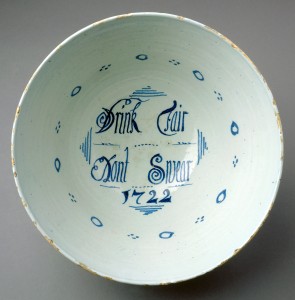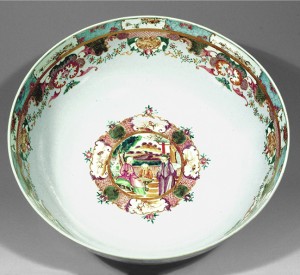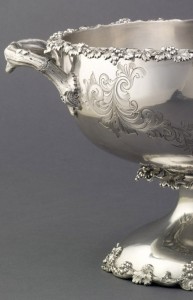
Boy, bring a bowl of China here,
Fill it with water cool and clear;
Decanter with Jamaica ripe,
And spoon of silver, clean and bright,
Sugar twice-fin’d in pieces cut,
Knife, sieve, and glass in order put,
Bring forth the fragrant fruit, and then
We’re happy till the clock strikes ten.
Benjamin Franklin, Poor Richard’s Almanack (June, 1737)
The Dutch term punch may come from the sanskrit pañca, for five, and the “Rule of Five” states that punch required “One sour, Two sweet, Three strong, Four weak, and spices makes Five.” Many recipes included rum although white and red wines, gin, and other alcoholic beverages were also popular ingredients. Punch bowls were in use in theNetherlands in the early 1600s but were rare in England until after the 1660s. Within a few decades, punch drinking also gained popularity in America.
Punch was served in homes, taverns, and inns and also played an important role in public celebrations. In 1754 Lord Baltimore’s 23rd birthday was celebrated with a ball, cannon fire, a bonfire on the Baltimore Common, and punch distributed to “the Populace.” In 1766 Philadelphians honored George III’s 28th birthday, and the public was provided with “Rum, Sugar, and Water, to make Punch.”
 Punch bowl
Punch bowl
Jingdezhen, China; 1620–40
Porcelain (hard paste)
Gift of Osborne R. and Mary M. Soverel, given in memory of Lillian Wilkinson Boschen 1992.34
This rare and early example is one of nearly 200 ceramic punch bowls at Winterthur, 64 of which are from China. It is among the largest made in so-called kraakporselein, first brought to the West by the Portuguese and Dutch East India Companies. 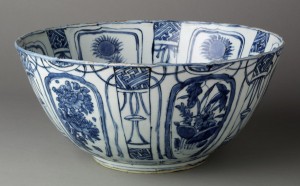 Although not of the quality made for luxury use in China, exported wares of this type were destined for wealthy households in the West, especially continental Europe and England. Based on archaeological evidence, they were also occasionally acquired by American colonists.
Although not of the quality made for luxury use in China, exported wares of this type were destined for wealthy households in the West, especially continental Europe and England. Based on archaeological evidence, they were also occasionally acquired by American colonists.
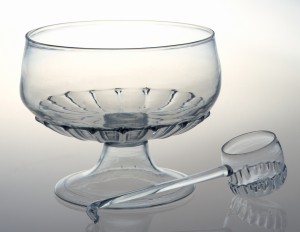
Punch bowl and ladle
England; 1690–1710
Glass (lead)
Gift of Donald Hayes 1996.21.1, .2
Although less common than ceramic versions, glass punch bowls were available in England, continental Europe, and colonial America by the early 1700s. The 1743/4 inventory of the “Goods in the Shop” of New Castle, Delaware, merchant Richard Grafton includes “5 Delph Punch Bowls” and a “Glaƒs punch Bowl & Cover.” In 1760 the Williamsburg, Virginia, tavern of Henry Wetherburn had a “Glass Bowl and Ladle,” probably for use by its wealthier clientele.
Punch bowl
Probably Bristol, England; dated 1722
Earthenware (delftware)
Inscribed “Drink Fair / Dont Swear / 1722”
Bequest of Henry Francis du Pont 1960.1014
The “Drink Fair/ Dont Swear” inscription on this bowl suggests that it was used in an informal setting by a group of friends intent on “having a good time.” The ornament on the exterior imitates Chinese export porcelain motifs, and the deep profile is appropriate for the 1722 date on the interior. Punch bowls became wider and more saucer shape as the century progressed.
Punch bowl
Jingdezhen, China; 1770–80
Porcelain (hard paste)
Promised gift of Mr. and Mrs. Daniel Nadler
This brilliantly colored Chinese punch bowl is painted in a palette sometimes known as mandarin, a term 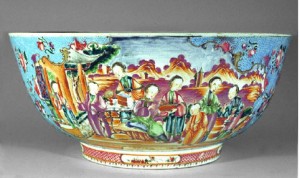 associated with the figural subject matter. The blue ground was inspired by fashionable “pebbled” grounds on elegant Meissen porcelain from Germany. Bowls like this one were purchased by the wealthy in the West; less affluent consumers bought imitations in earthenware.
associated with the figural subject matter. The blue ground was inspired by fashionable “pebbled” grounds on elegant Meissen porcelain from Germany. Bowls like this one were purchased by the wealthy in the West; less affluent consumers bought imitations in earthenware.
Nest of punch bowls
 London or Bristol, England; 1740–50
London or Bristol, England; 1740–50
Tin-glazed earthenware (delftware)
Gift of Mrs. Nancy du Pont Reynolds 2003.22.4, .5, .8
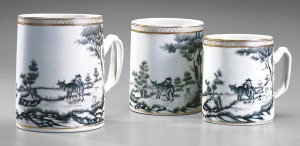 Graduated set of mugs
Graduated set of mugs
Jingdezhen, China; 1800–1810
Porcelain
Gift of Leo A. and Doris C. Hodroff 2000.61.71.1-.3
Powdered manganese-ground delft bowls with fish decoration have been excavated from many colonial American sites. The fish were references to drinking. As was true of “nests” of punch bowls, sets of mugs for alcoholic drinks were sometimes produced in graduated sizes. The mugs here bear a popular design, apparently after a Dutch print, in shades of gray. Philadelphia Quakers Isaac and Mary Morris ordered a dinner service that included similarly ornamented mugs, and the same design is drawn and dated 1797 in Mary’s sketch book.
Strainer and ladle
Thomas and Samuel Edwards (strainer)
Samuel Edwards (ladle)
Boston, Massachusetts; 1745–60
Silver
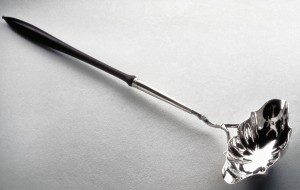 Museum purchase 1960.82, 1956.100
Museum purchase 1960.82, 1956.100
The wide handles, or “ears,” on the strainer supported it when resting on the rim of a punch bowl. Such utensils were useful aids in removing unwanted sediment from bottled punch mixtures and for straining fresh ingredients. The strainer is the only known silver marked by brothers Thomas and Samuel Edwards, whose father, John, was also a silversmith. The ladle features narrow pouring lips to facilitate the serving of punch into wineglasses. The wooden handle would have protected a server’s hand when pouring hot punch.
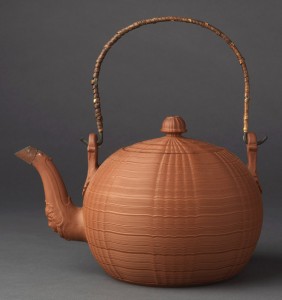 Punch pot
Punch pot
Staffordshire, England; 1760‒80
Stoneware (redware)
Museum purchase with Funds from Various Donors 2009.29
Resembling hot-water kettles used during the service of tea, some large-capacity pots are also associated with the service of punch. Examples survive in a variety of ceramic and metalwork types and presumably could be used to pour the heated drink into punch bowls.
To divert his thoughts from [a] melancholy subject, I informed Mr. Micawber that I relied upon him for a bowl of punch, and led him to the lemons.…I never saw a man so thoroughly enjoy himself amid the fragrance of lemon-peel and sugar, the odour of burning rum, and the steam of boiling water… . It was wonderful to see his face shining at us out of a thin cloud of these delicate fumes, as he stirred, and mixed, and tasted, and looked as if he were making, instead of punch, a fortune for his family…
Charles Dickens, David Copperfield (London, 1849)
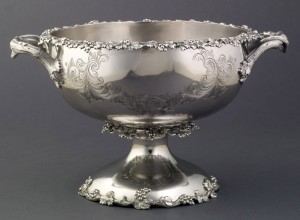 Punch bowl
Punch bowl
William Forbes
Ball, Black and Co. (retailer)
New York, New York; 1826–64
Silver
Gift of Mr. Carl R. Kossack 1990.47
Punch ladle
Jean Simon Chaudron and Anthony Rasch
Philadelphia, Pennsylvania; 1809–12
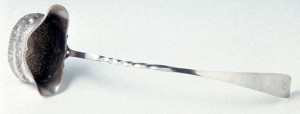 Silver
Silver
Inscribed “TP”
Museum purchase with funds provided by Mr. and Mrs. George H. Kaufman 1973.1
Silver punch bowls were much less common than ceramic ones. The fashionable 19th-century bowl shown here perhaps was made as a presentation piece. The Ball, Black and Co. mark on the bowl identifies the retailer, whose impressive new store at Broadway and Prince Street in New York is the topic of a detailed article in an 1860 issue of the New York Times: “The first three stories will be used for sale and show rooms, and the remainder for manufacturing purposes. The first story, intended as a sales-room for jewelry and silver ware, is fitted up in the most original, chaste and elegant style.” Like the punch bowl, the silver ladle displays repoussé ornament. The engraved script “TP” initials probably refer to the original owner.
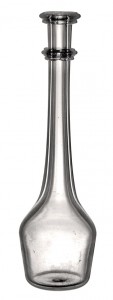 Punch or toddy lifter
Punch or toddy lifter
Probably England; 1800–1820
Glass (lead)
Gift of Mrs. John T. Tenneson 1963.103.2
Although it resembles a small decanter, this object is pierced at both ends. By submerging the larger end in a bowl of punch and then covering the hole at the top, one could neatly transfer a single serving of the drink to a glass.
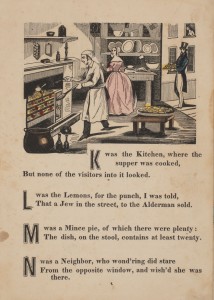 Grandmamma Easy’s Alderman’s Feast: A New Alphabet
Grandmamma Easy’s Alderman’s Feast: A New Alphabet
Albany, New York: Steele & Durrie, 1834?
Printed Book and Periodical Collection, Winterthur Library PZ6 G75
These pages from a children’s alphabet book tell of the making of punch for an elegant party. What now might seem politically incorrect provides insight into occupations at the time the book was written.
L was the Lemons, for the punch, I was told
That a Jew in the street, to the Alderman sold.
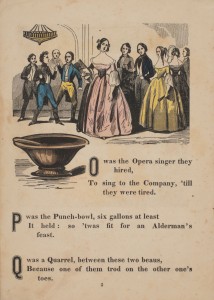 Lemons were a common ingredient for punch. Some wealthy households grew their owncitrus fruit; other consumers purchased it from shops or street vendors. Another page from the book shows a large, presumably metalwork bowl and ladle and tells us:
Lemons were a common ingredient for punch. Some wealthy households grew their owncitrus fruit; other consumers purchased it from shops or street vendors. Another page from the book shows a large, presumably metalwork bowl and ladle and tells us:
P was the Punch-bowl, six gallons at least
It held: so ’twas fit for the Alderman’s feast.
Related Themes:

